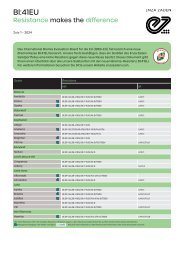Cultivation guidelines Tomagino 2017
You also want an ePaper? Increase the reach of your titles
YUMPU automatically turns print PDFs into web optimized ePapers that Google loves.
<strong>Tomagino</strong><br />
<strong>Cultivation</strong>al <strong>guidelines</strong><br />
The sweet and<br />
crunchy cherry on the vine<br />
Resistances: HR: ToMV:0-2/Va:0/Vd:0/Fol:0/For<br />
IR: On<br />
Main distinctive characteristics:<br />
• Excellent sweet taste right from the first truss.<br />
• A sweet taste all year round.<br />
• Consistently high quality all year round.<br />
• Very resistant to fruit cracking/splitting.<br />
• Very low percentage of class 2 tomatoes.<br />
• Regular and uniform vines.<br />
• Productive.<br />
• Powdery Mildew resistance (IR).<br />
enzazaden.com
<strong>Tomagino</strong><br />
Characteristics<br />
<strong>Tomagino</strong> is a cherry tomato on the vine with an average fruit weight of 19-20 grams. This<br />
variety stands out due to its consistent and high quality and flavour, and a crunchy “bite”.<br />
<strong>Tomagino</strong> produces cherry tomatoes with a very good, sweet taste from the first to the last<br />
vine. Brix levels of 10 are no exception.<br />
This variety is very resistance to split/cracked fruit, blossom end rot and shrinkage tears and<br />
therefore produces a very low percentage of class 2 tomatoes.<br />
Rootstock and cultivation<br />
<strong>Tomagino</strong> is generative in nature and requires a vigorous rootstock. During plant propagation<br />
<strong>Tomagino</strong> can be grown at higher 24hr temperatures and with less day-night difference than<br />
other varieties, due to its naturally generative nature.<br />
Lighting can be used, depending on the grower’s wishes and time of planting.<br />
Start of cultivation<br />
<strong>Tomagino</strong> is easily balanced due to its generative nature and open crop growth. This means<br />
that this variety is well-suited to a fairly level temperature regime. The aim is to cultivate a<br />
strong plant.<br />
We assume that the mats have been drip-irrigated with an EC of 3.8 – 4.2 mS/cm. With the<br />
exception of the period after being placed on the plant hole - during which the mat EC will<br />
increase sharply - the target EC value for the mat should ideally be between 4.5-5 mS/cm.<br />
The plant is placed on the plant hole before the first flower.<br />
<strong>Cultivation</strong><br />
<strong>Tomagino</strong> is not a variety that tolerates extremes of temperature very well. The generative<br />
growth of this variety necessitates a fairly even and active growth strategy. Fruit setting<br />
occurs quite easily, even in poor light conditions, meaning that low pre-night temperatures<br />
are not necessary. Depending on the light conditions, the pre-night requirement will be in the<br />
region of 15 °C - 17 °C, with a temperature around 18 °C during the latter part of the night<br />
(+0.5 °C light). Maintain at least 16 °C if the weather is cold and clear.<br />
As the vine is quite compact in shape, it is important to achieve daytime temperature at<br />
0.5 hours before sunrise in order to achieve sufficient stretching.<br />
The afternoon temperatures should be maintained at a “normal” level - avoid extremes -<br />
particularly during the first months of growth. A guideline is a maximum of 26 °C in<br />
combination with a venting temperature between 21 °C and 24 °C. Of course this all depends<br />
on light levels and external conditions.<br />
<strong>Tomagino</strong> produces an open crop type with relatively short leaves. It is important to maintain<br />
sufficient leaf span, particularly during the summer period.<br />
Truss pruning and treatment<br />
The vine, with an average of 16-18 flowers, is regular in structure and will produce few to no<br />
split vines. A vine pruning strategy for vines 1 through 6 could be: 10fr/10fr/11fr/12fr/<br />
12fr/12fr/13-14fr.<br />
Despite the fact that the truss stems are strong, kinked trusses can occur in the initial phase<br />
with low light conditions. It is not essential, but one could consider supporting a number of<br />
trusses.<br />
A movable and/or permanent screen is often used. Special attention should be paid to the<br />
use of these screens. If external conditions are mild and darker, then the screen should,<br />
if possible, be opened quickly to prevent growth of a weak and elongated plant. Active<br />
cultivation should always be the goal. In the case of a permanent screen, a tomato crop will<br />
easily get too long under these conditions. This should be taken into account when deciding<br />
on the climate settings, fertilisation (higher EC) and when to remove a permanent screen.<br />
Fertilisation<br />
Currently, no specific points of attention regarding fertilisation are known. However, it is<br />
important to monitor the ratio of Potassium/Calcium. Target figures in the mat are<br />
K 5 – 6 mmol/L ; Ca 10 – 11 mmol/L.
enzazaden.com<br />
Enza Zaden<br />
P.O. Box 7 | 1600 AA Enkhuizen | The Netherlands<br />
Haling 1E | 1602 DB Enkhuizen | The Netherlands<br />
Tel +31 (0)228 35 01 00 | fax +31 (0)228 35 02 00<br />
info@enzazaden.nl | www.enzazaden.com<br />
Descriptions, recommendations and illustrations in brochures and leaflets shall correspond as closely as possible to tests and practical<br />
experience and are subject to typographical and/or printing errors. This information shall be provided to assist professional growers and<br />
users, whereby variable local conditions must be taken into account. Under no circumstances shall Enza Zaden accept liability based on such<br />
information for deviating results in the cultivated product. © Enza Zaden | Enkhuizen | the Netherlands | November <strong>2017</strong>
















